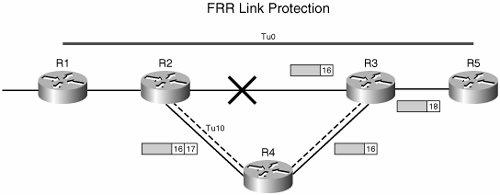MPLS Fast Reroute
| MPLS fast reroute (FRR) involves the following:
FRR also offers node protection, which is more complex. Look at Figure B-6 and imagine that node R3 fails. Node R2 detects this and forwards traffic across the backup LSP, Tu10. However, the subtlety is that router R5 needs to see the same label as before the failure so that it can forward traffic along the correct LSP. R2 has to know which label R5 was expecting (16 in the case of Figure B-6) and push that value on the label stack as it sends the packet across the backup tunnel. In either case, if failure detection is quick enough, FRR can allow subsecond network reconvergence. Figure B-6. FRR Node Protection Note Figure B-6 is a modification from the "Advanced Topics in MPLS-TE Deployment" white paper at http://www.cisco.com/. Although we did not go into detail here, MPLS-TE supports the notion of priority and preemption. Low-priority tunnels can be removed to free up bandwidth for higher-priority tunnels. |
EAN: 2147483647
Pages: 128
